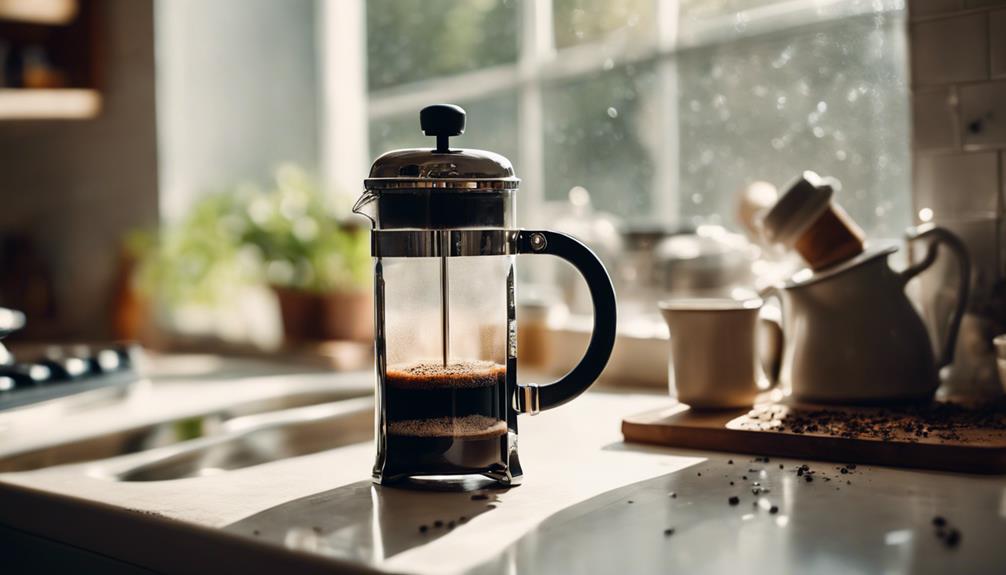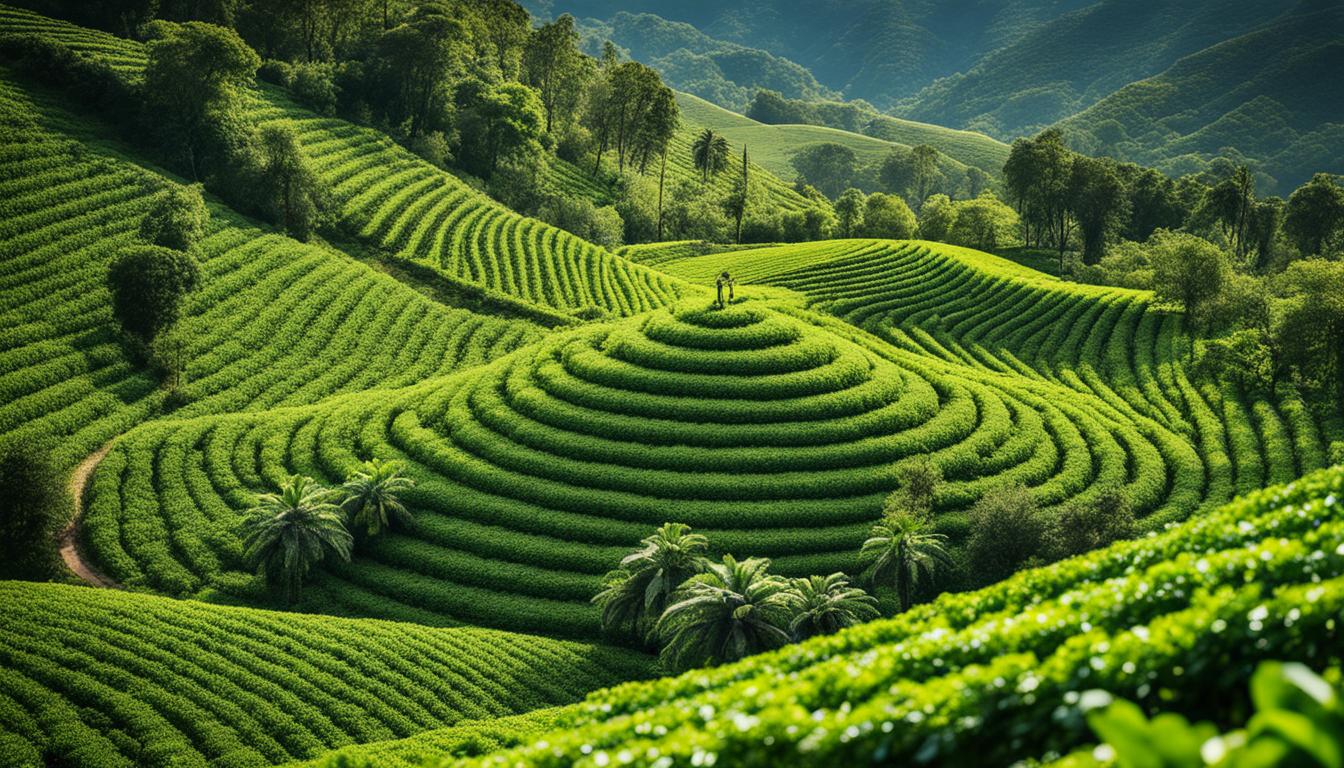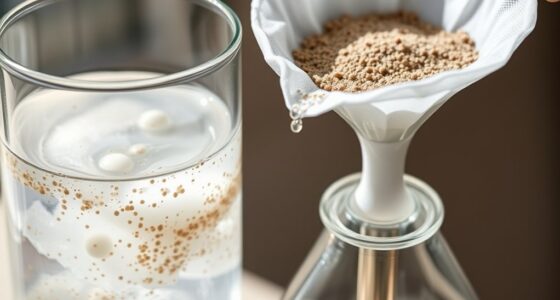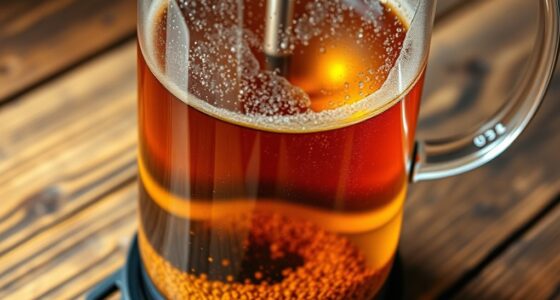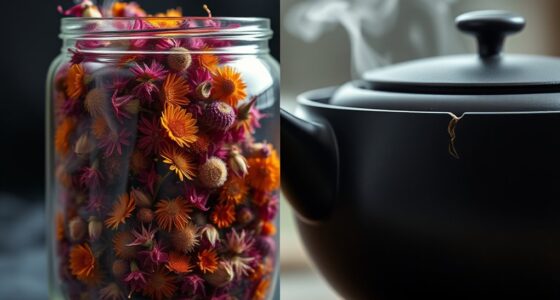A French Press coffee maker combines coarse ground coffee beans with hot water, usually around 200°F, for brewing. Start by adding the grounds to the beaker, pouring hot water over them to ensure they are completely soaked, and letting them steep for approximately four minutes. Press down the plunger, which is equipped with a metal mesh filter, to separate the coffee from the grounds. This design permits essential oils and fine particles to flow through, resulting in a rich flavor. It is crucial to use the correct grind size and timing to avoid over-extraction and bitterness. To grasp the subtleties of each step, take into account the specific techniques utilized.
Key Takeaways
- Coarsely ground coffee and hot water steep together in the beaker for about four minutes.
- The plunger with a metal mesh filter is pressed down to separate the grounds from the brewed coffee.
- The metal filter allows essential oils and fine particles to pass through for a full-bodied flavor.
- The lid prevents grounds from escaping into the coffee when pouring.
- The French Press offers control over steeping time, impacting the strength and flavor of the coffee.
French Press Components
The French Press is composed of a beaker, plunger, and filter, each playing an essential role in the brewing process. These components work together to create a unique and rich coffee experience.
The French press coffee maker's beaker, typically made of glass or stainless steel, holds the hot water and coffee grounds. It's designed to withstand high temperatures and allows you to observe the brewing process.
The plunger is connected to a metal rod and is essential for pressing the coffee grounds to the bottom of the beaker. Attached to the plunger is a metal filter, which plays a critical role. Unlike paper filters, this metal filter allows the natural oils and fine particles from the coffee grounds to pass through, giving French press coffee its distinct texture and flavor.
The lid of the French press fits securely onto the beaker, ensuring that no coffee grounds escape during brewing. Additionally, the handle is ergonomically designed to allow for easy and safe pouring of the brewed coffee.
Each of these components—the beaker, plunger, metal filter, lid, and handle—comes together to make the French press coffee maker a highly effective tool for brewing rich, flavorful coffee.
Brewing Process Overview
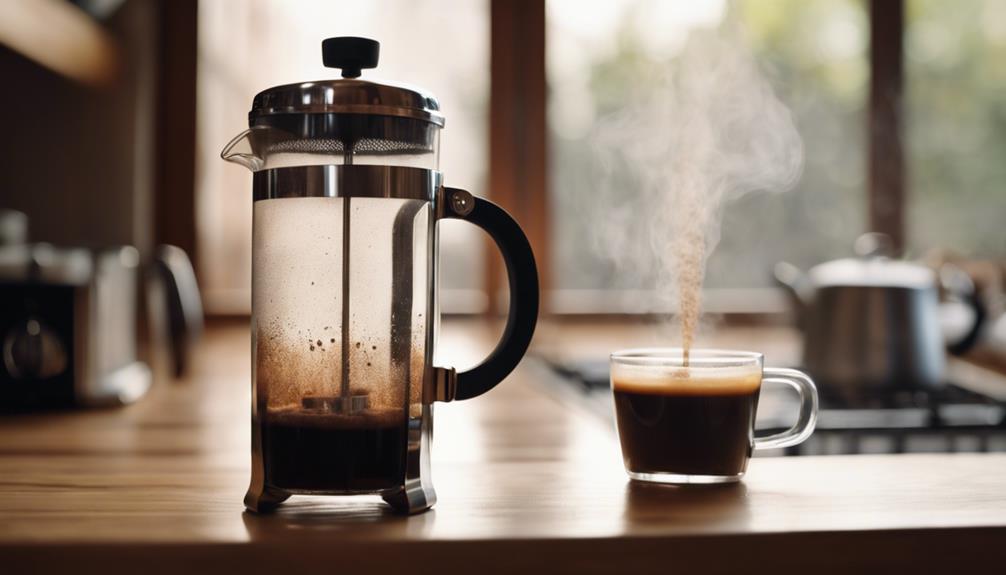
Brewing coffee with a French press involves steeping coarsely ground beans in hot water, guaranteeing a rich and robust flavor. To get started, use French press recipes that call for coarse-ground coffee, as finer grinds can clog the metal mesh filter.
Begin by heating water to around 200°F, which is perfect for ideal flavor extraction. Pour the hot water over the coarse-ground coffee in the French press, and stir gently to make sure all the grounds are fully saturated.
The immersion brewing method is employed here, meaning the coffee grounds remain in contact with the hot water throughout the brewing process. This method ensures consistent flavor extraction, allowing the coffee's natural oils and flavors to fully develop.
Let the coffee steep for about four minutes, a standard time recommended in many French press recipes.
After steeping, press down the plunger slowly and steadily. The metal mesh filter attached to the plunger will separate the grounds from the brewed coffee, allowing you to enjoy a cup free from sediment.
This process not only allows for full control over the brewing process but also results in a rich and robust coffee flavor that many enthusiasts appreciate.
Required Equipment
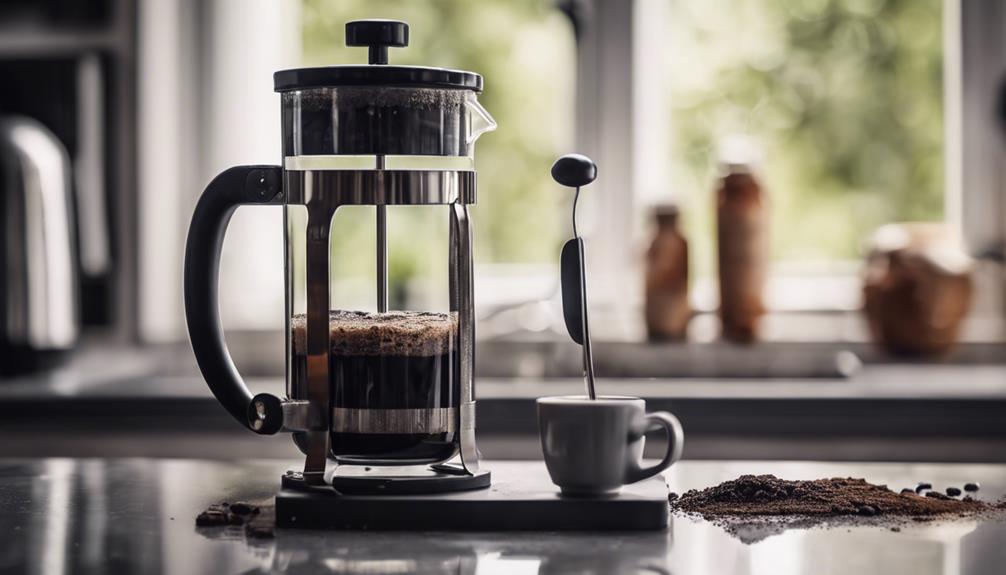
To effectively use a French Press, you'll need three essential components: the French Press itself, coarsely ground coffee, and hot water at the right temperature.
The French Press consists of a beaker, a plunger, and a metal mesh filter that work together to steep and separate the coffee grounds from the liquid.
Ensuring you have the correct coffee grounds and water temperature is vital for achieving the best flavor and extraction.
French Press Components
When you're setting up your French Press, you'll need a beaker, plunger, metal filter, and a lid to get started. These components are essential to the brewing process and guarantee you get a smooth, rich cup of coffee.
The beaker, often made of glass, metal, plastic, or ceramic, is where you combine your coffee grounds and hot water. This container must withstand high temperatures and provide a clear view of the brewing process.
The plunger, connected to the metal filter via a sturdy metal rod, is designed to press the filter down through the coffee mixture. The metal filter is vital as it separates the coffee grounds from the brewed coffee, allowing the liquid to flow through while trapping the grounds. This fine mesh ensures that your coffee is free from sediment.
Lastly, the lid fits securely onto the top of the beaker, helping to prevent heat loss and maintain ideal brewing conditions. This lid often features a small opening for pouring, making it convenient to serve your freshly brewed coffee without removing it entirely.
These components work together to create a consistent and enjoyable coffee experience.
Necessary Coffee Grounds
Now that you understand the components of a French Press, let's explore the importance of using the right coffee grounds for best brewing results.
The grind size of your coffee grounds plays a significant role in flavor extraction and the overall quality of your brew. For a French Press, you'll need coarse grounds. Coarse grounds are essential because they prevent the coffee particles from passing through the metal filter, ensuring a clean and smooth cup.
Using coarse grounds aids in a slower extraction process, allowing more of the coffee's natural oils and flavors to pass through the metal mesh filter. This results in a rich and robust flavor profile, which is the hallmark of a well-brewed French Press coffee.
On the other hand, using fine grounds can lead to over-extraction. Over-extraction occurs when the coffee grounds are too fine, causing them to dissolve too quickly and release excessive bitter compounds, thereby ruining the taste of your coffee.
Water Temperature Essentials
Achieving the ideal water temperature is crucial for brewing a delicious French Press coffee, and having the right equipment can make all the difference. The French Press requires water at around 200°F for best flavor extraction.
Water temperature greatly impacts the taste of your coffee – water that's too hot can lead to a burnt flavor, while cooler water might result in under-extraction, leaving your coffee weak and unsatisfying.
To make sure you consistently reach the ideal 200°F, consider using the following equipment:
- Thermometer: A simple kitchen thermometer can help you measure the exact temperature of your water, making sure you hit that 200°F mark every time.
- Electric Kettle with Temperature Control: This handy device allows you to set the precise temperature you need, making the process straightforward and repeatable.
- Stovetop Kettle: While less precise, you can still achieve the desired temperature by boiling water and then letting it sit for about 30 seconds.
- Insulated Carafe: Once you've heated your water, an insulated carafe can help maintain the correct temperature as you prepare your French Press.
Using the right equipment ensures your water temperature is perfect, enhancing the taste of your French Press coffee and avoiding issues like burnt flavor or under-extraction.
Coffee to Water Ratio
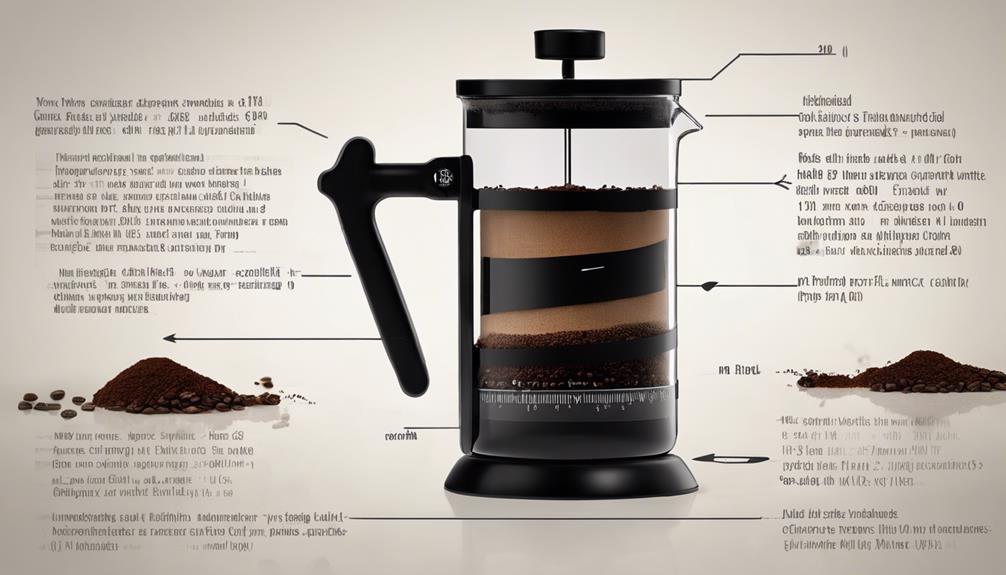
When preparing French press coffee, the ideal coffee to water ratio is 1:16, which means using 1 gram of coffee for every 16 grams of water.
Adjusting this ratio allows you to control the strength and flavor of your brew, catering to personal preferences.
Using a scale to measure both ingredients guarantees consistency and helps achieve a balanced, flavorful cup every time.
Ideal Brewing Measurements
Finding the perfect coffee to water ratio is key to brewing a delicious cup of French press coffee. The ideal measurements for the French press typically follow a coffee to water ratio of 1:16, which translates to 1 gram of coffee for every 16 grams of water. This ratio serves as a foundational guideline, ensuring a balanced and flavorful cup. During the brewing process, adhering to this ratio allows for the best extraction of coffee flavors, enhancing the overall flavor profile.
However, you can adjust ratios based on personal taste preferences. If you're aiming for a stronger brew, you might use a ratio of 1:15, while a milder cup could call for a 1:17 ratio. This customization lets you fine-tune the coffee's strength and flavor according to your liking.
To paint a clear picture, here are the steps for ideal brewing measurements:
- Measure your coffee beans: Use a kitchen scale to weigh out your coffee beans accurately.
- Grind the coffee: Coarsely grind the measured coffee beans for best extraction.
- Boil water: Heat the water to the appropriate temperature, typically just off the boil.
- Combine and brew: Add the coffee grounds to the French press, pour in the water, and let it steep for about four minutes.
Adjusting Strength Preferences
You can easily adjust the strength of your French press coffee by tweaking the coffee-to-water ratio to suit your taste preferences. The standard ratio of 1:16, where 1 gram of coffee is used for every 16 grams of water, serves as a baseline. However, adjusting this ratio can help you personalize the flavor profile to achieve your desired strength.
To fine-tune your coffee, consider experimenting with different ratios. A higher coffee-to-water ratio results in a stronger brew, while a lower ratio yields a milder cup. Consistency in your measurements is vital to achieving the same strength and flavor each time you brew.
Here's a guide to help you adjust the coffee-to-water ratio:
| Coffee (grams) | Water (grams) | Strength |
|---|---|---|
| 1 | 16 | Standard |
| 1 | 14 | Stronger |
| 1 | 18 | Milder |
| 1 | 12 | Very Strong |
| 1 | 20 | Very Mild |
Experimentation is key to discovering what suits your palate best. By meticulously adjusting the ratio, you can guarantee that each cup of French press coffee matches your strength preferences, offering a consistent and enjoyable flavor profile every time.
Standard Proportion Guidelines
Understanding the standard coffee-to-water ratio is essential for brewing a well-balanced and flavorful French press coffee. The recommended ratio is 1:16, meaning 1 gram of coffee to 16 grams of water. This foundational guideline guarantees a balanced extraction, allowing the coffee's intricate flavors to shine.
Here's how you can apply this ratio:
- Measure the Coffee: Use a scale to measure 1 gram of coffee for every 16 grams of water you plan to use.
- Adjust Ratio: If you prefer a stronger brew, you can experiment with different ratios, such as 1:15 or even 1:14.
- Customize Coffee Strength: For a milder cup, try a 1:17 or 1:18 ratio to find your ideal flavor profile.
- Proportioning Coffee: Properly proportioning coffee to water is vital, so always measure accurately to achieve consistent results.
Heating the Water
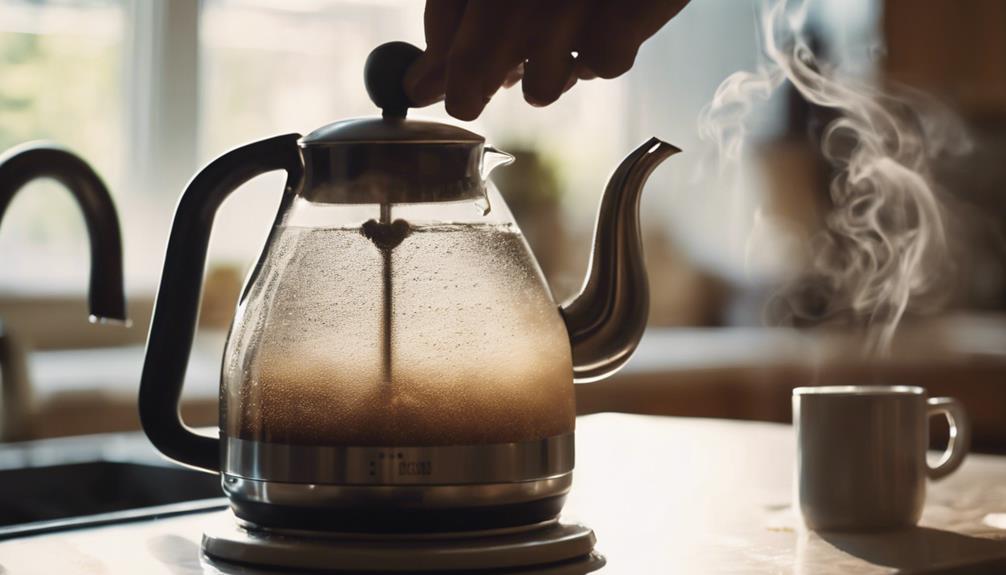
To achieve the perfect brew, start by heating your water to around 200°F. This temperature is essential for your French Press as it guarantees the coffee grounds steep properly, leading to ideal flavor extraction. If your water is too hot, reaching the boiling point of 212°F, it can burn the coffee grounds, resulting in a bitter taste. Conversely, if the water is too cool, it won't extract the flavors adequately, leaving you with a weak, underwhelming cup.
You can heat your water on a stove or use an electric kettle. Both methods are effective, but make sure to monitor the water temperature closely. Using a thermometer can help you achieve the precise 200°F needed.
Here's a quick guide to water temperatures and their effects:
| Water Temperature | Effect on Coffee | Ideal for French Press? |
|---|---|---|
| 212°F | Burns grounds | No |
| 200°F | Optimal extraction | Yes |
| 190°F | Under-extracted | No |
| 180°F | Weak flavor | No |
| Room Temp | No extraction | No |
Grinding the Coffee
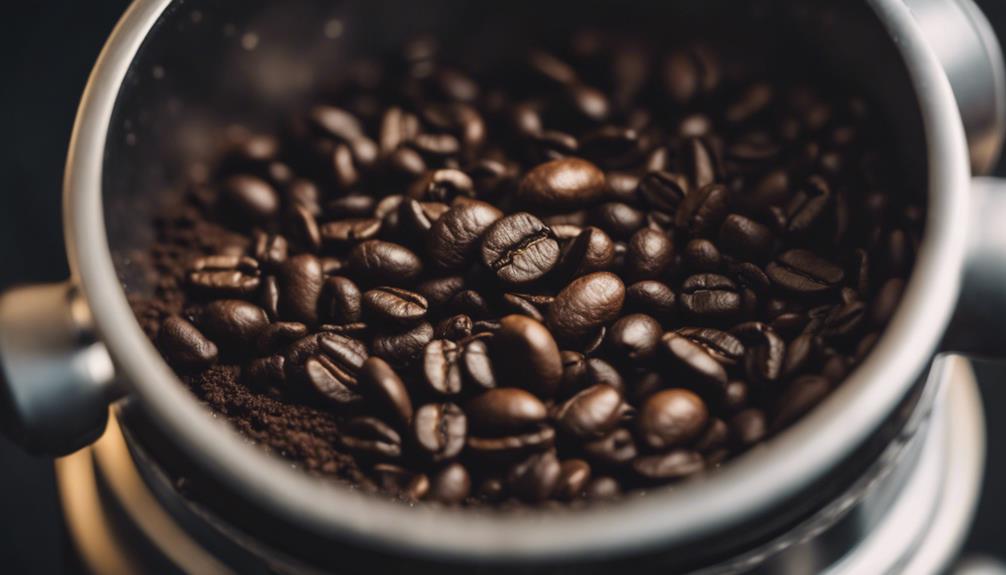
After heating your water to the perfect temperature, the next step is grinding the coffee beans to the right consistency. For a French Press, a coarse grind is essential to prevent grounds from passing through the filter, guaranteeing a clean cup of coffee. Coarse grinds allow for a slower extraction process, which enhances flavor extraction, resulting in a more flavorful and robust brew.
Grinding coffee too fine can lead to over-extraction, causing a bitter taste in your final cup. The recommended grind size for a French Press is similar to breadcrumbs, striking the ideal balance for best flavor extraction. Consistency and uniformity in your coffee grind are critical to achieving a balanced and rich coffee flavor.
To help you visualize the process, here's a quick guide:
- Select Quality Beans: Start with fresh, whole coffee beans for the best flavor.
- Set Your Grinder: Adjust your grinder to a coarse setting, aiming for a grind size similar to breadcrumbs.
- Grind Consistently: Ensure all your coffee grounds are uniform to avoid over or under-extraction.
- Measure Correctly: Use the right coffee-to-water ratio, typically one ounce of coffee to 15 ounces of water.
Combining Ingredients
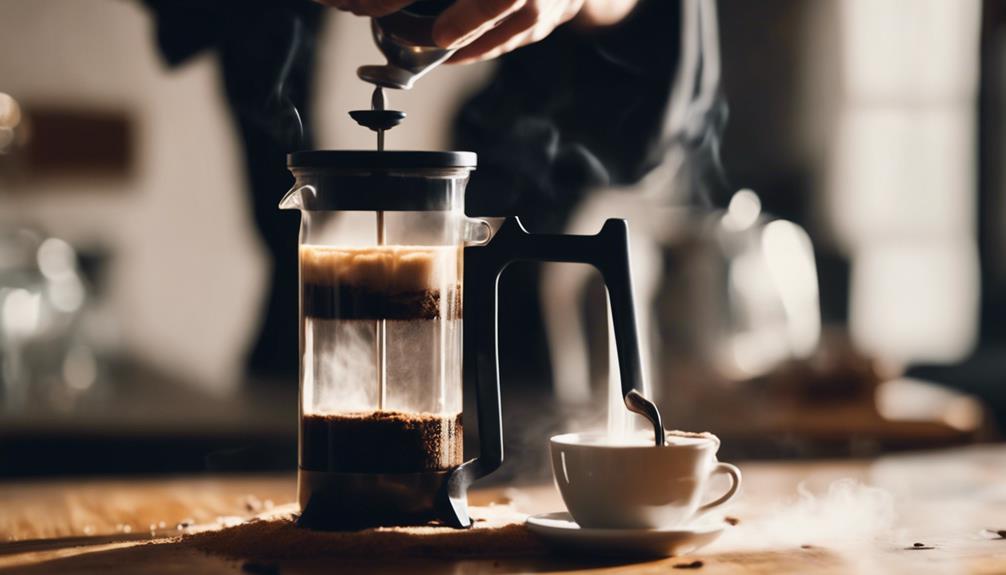
Start by pouring the coarse-ground coffee into the French press beaker. Ensuring that the coffee grounds are coarse is essential, as it allows for proper extraction of flavors without clogging the metal mesh filter.
Once the coffee grounds are in the beaker, it's time to pour hot water over them. The water should be just below boiling, around 200°F (93°C), to optimize the infusion process.
Carefully pour hot water in a steady stream, making sure all the grounds are fully saturated. This step is vital for allowing the flavors to infuse effectively. As the hot water mingles with the coarse-ground coffee, the brewing process begins, releasing the rich, aromatic characteristics of the coffee beans.
Next, place the lid on the French press with the plunger pulled all the way up. The metal mesh filter attached to the plunger will eventually be used to separate the brewed coffee from the grounds. However, for now, let the mixture sit undisturbed. This phase is crucial for achieving a well-balanced liquid coffee. The flavors from the coffee grounds will continue to infuse into the water, preparing for the final pressing step.
Steeping and Timing
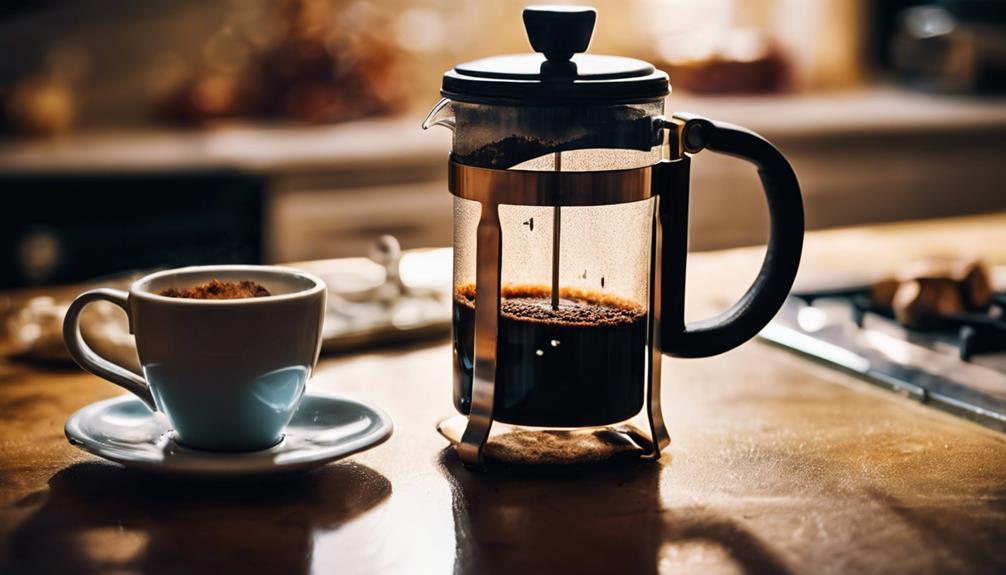
Steeping your coffee grounds for the right amount of time, typically 3 to 4 minutes, is crucial for achieving a balanced and flavorful cup. The steeping time in a French Press directly affects the best extraction of flavors from the coffee grounds.
Here's what you need to know to guarantee a well-balanced brew:
- Measure Your Coffee and Water: Use a ratio of about 1:15 (coffee to water). For instance, 30 grams of coffee to 450 grams of water.
- Set a Timer: Start your timer as soon as you pour hot water over the coffee grounds. This ensures that your steeping time is accurate.
- Monitor the Steeping: Keep an eye on the time to avoid over-extraction, which can lead to bitterness. A steeping time beyond 4 minutes can negatively impact the flavor.
- Prepare for Plunging: After the steeping time, use the metal mesh filter to separate the grounds from the liquid by slowly pressing down the plunger.
Pressing and Serving
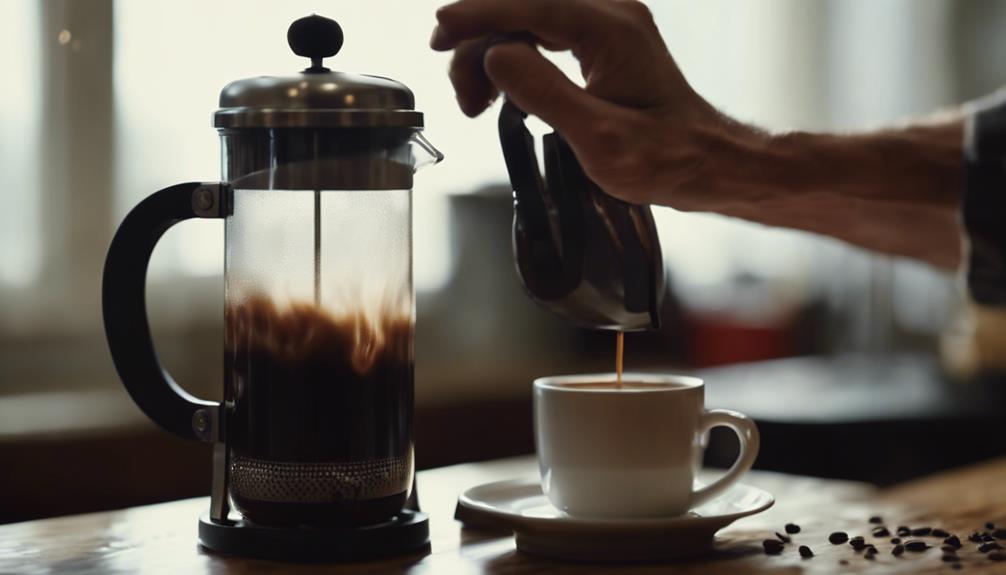
Pressing down the plunger in a French Press separates the coffee grounds from the brewed coffee, guaranteeing a smooth and flavorful pour. This action is vital for achieving a well-balanced cup. The plunger, equipped with a metal mesh filter, allows the liquid coffee to pass through while effectively trapping the grounds. By pressing the filter to the bottom of the beaker, you ensure that the coffee remains free of sediment, resulting in a clean and enjoyable beverage.
Once the plunger is fully depressed, serving the coffee immediately is crucial. Delaying this step can lead to over-extraction, which occurs when the coffee grounds remain in contact with the water for too long, resulting in a bitter and unpleasant taste. Therefore, prompt serving is key to maintaining the ideal flavor profile of your brewed coffee.
The design of the French Press facilitates easy and efficient serving. As you pour, the metal mesh filter ensures that no grounds escape into your cup, providing a sediment-free experience. This method not only enhances the overall quality of the coffee but also simplifies the serving process, making the French Press a preferred choice for many coffee enthusiasts.
Frequently Asked Questions
How Does the French Press Coffee Maker Work?
The French press coffee maker operates by immersing coarse coffee grounds in hot water, typically around 200°F, allowing them to steep for several minutes.
You then press a metal mesh filter through the mixture, effectively separating the grounds from the brewed coffee.
This immersion brewing method guarantees a consistent extraction of flavors, resulting in a rich and robust coffee.
Importantly, the French press doesn't require electricity, making it a straightforward and effective brewing method.
Why Use a French Press Instead of Coffee Maker?
Imagine waking up to the rich aroma of coffee oils and flavors that a French Press captures, unlike drip coffee makers.
You gain full control over brewing variables, ensuring a customized experience.
It's versatile for cold brews, teas, or herbal infusions. Plus, it's eco-friendly since you're not using paper filters.
A French Press not only enriches taste but also promotes sustainability, making it a superior choice.
Do You Need Coffee Filters for a French Press?
You don't need coffee filters for a French Press because it uses a built-in metal mesh filter. This filter allows natural oils and fine particles to pass through, enhancing the coffee's flavor and texture.
The plunger with the metal mesh filter efficiently separates the grounds from the liquid, resulting in a rich and robust coffee. Therefore, the absence of paper filters contributes to a fuller-bodied coffee experience.
Can You Use Regular Ground Coffee in a French Press?
Yes, you can use regular ground coffee in a French press, but there's a catch. Regular ground coffee might lead to over-extraction and a gritty texture that diminishes the experience.
For the best results, choose coarser ground coffee. It allows for ideal flavor extraction and minimizes the silty residue at the bottom of your cup, ensuring a clean and flavorful brew every time.
What are the Steps for Using a French Press Coffee Pot?
To use a French press coffee pot, start by adding coarse coffee grounds to the pot. Then, pour hot water over the grounds, stir, and let it steep for about four minutes. After that, press down the plunger slowly to separate the grounds from the coffee. That’s the coffee press operation explained. Additionally, it’s important to note the importance of using the right ratio of coffee to water for the best flavor. Understanding how a coffee press works can greatly improve the quality of your brew. By allowing the coffee grounds to steep in hot water and then using the plunger to separate them, the French press creates a rich and bold flavor that is favored by many coffee enthusiasts. Understanding the process of how a coffee press works can help you achieve the perfect cup of coffee every time.
Conclusion
Just as an artist combines colors to create a masterpiece, using a French press requires precise steps. By understanding each component and following the brewing process closely, you'll produce a rich, flavorful coffee.
From the accurate coffee-to-water ratio to the exact timing for steeping, each detail matters. Embrace this method, and you'll appreciate how its simplicity belies the complexity behind a perfect cup.
Mastery of the French press is truly an art in itself.
